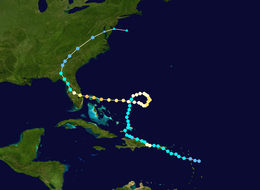Meteorological history of Hurricane Jeanne
| Category 3 major hurricane (SSHWS/NWS) | |

Path of Hurricane Jeanne
|
|
| Formed | September 13, 2004 |
|---|---|
| Dissipated | September 29, 2004 (Became extratropical on September 28) |
| Highest winds |
1-minute sustained: 120 mph (195 km/h) |
| Lowest pressure | 950 mbar (hPa); 28.05 inHg |
| Areas affected | U.S. Virgin Islands, Puerto Rico, Dominican Republic, Haiti, Bahamas, Florida; flooding and damage in other eastern U.S. states |
| Part of the 2004 Atlantic hurricane season | |
|
|
|
The meteorological history of Hurricane Jeanne lasted for about two weeks in September 2004. Hurricane Jeanne was the eleventh tropical cyclone, tenth named storm, seventh hurricane, and sixth major hurricane of the 2004 Atlantic hurricane season. It formed from a tropical wave on September 13 near the Lesser Antilles, and encountered favorable enough conditions to reach tropical storm status. Jeanne strengthened further in the eastern Caribbean Sea, becoming a strong tropical storm and developing an eye before striking Puerto Rico on September 15. Remaining well-organized, it attained hurricane status before hitting the eastern tip of the Dominican Republic on September 16.
Hurricane Jeanne steadily weakened while crossing eastern Hispaniola, and on September 17 it briefly weakened to tropical depression status after reaching open waters. Its original circulation dissipated as a new one reformed closer to the main area of thunderstorms. Turning northward, Jeanne slowly reorganized and again reached hurricane status on September 20. It executed a clockwise loop to the west, weakening due to upwelling upon reaching its path again. Jeanne encountered favorable conditions as it continued westward, and it reached major hurricane status before crossing the northern Bahamas on September 25. The next day, it struck Martin County, Florida in nearly the same location as Hurricane Frances just weeks before. Jeanne weakened over land while turning the northwest, deteriorating to tropical depression status over Georgia on September 27. It turned northeastward, becoming extratropical on September 28 before dissipating on September 29 after merging with a cold front.
...
Wikipedia
